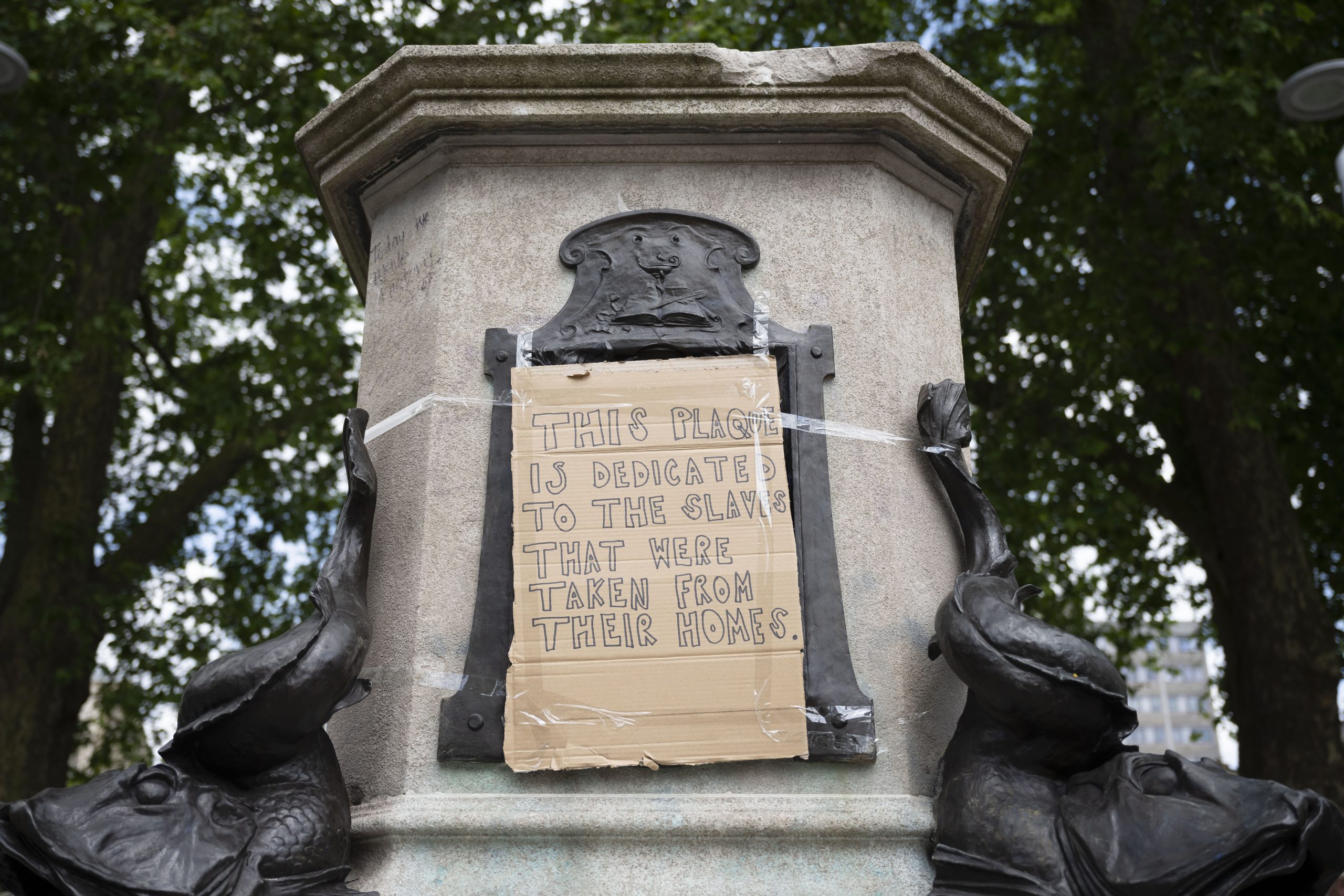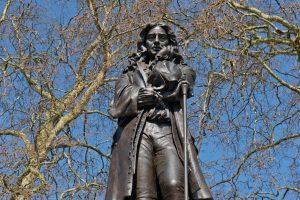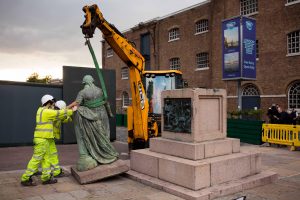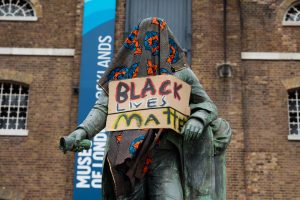Which statues are being removed across the UK and what will be done with them?
Calls for statues of slave traders to be removed have increased across in the UK in the last few weeks.


Following the statue of Edward Colston in Bristol being removed by protestors, many people are wondering what other statues are being removed across the UK.
Since the death of George Floyd in the US, protests have sparked up across the world to demand justice and change in society. Part of this has been campaigns to take down iconography of the slave trade and statues are being removed in the UK that depict people known to be racist.
The first statue to fall was the one depicting known slave-trader Edward Colston in Bristol, a man responsible for the deaths of over 19,000 people. On Sunday, Black Lives Matter protestors toppled the statue before rolling it into the harbour. To ensure the same fate doesn't meet some of the statues in the capital, London mayor Sadiq Khan has already removed one statue depicting a slave trader.
Debate has taken over the news cycle as a result, with academics and politicians, activists and regular people all taking an interest in which statues are being removed and where they will end up.
What statues are being removed across the UK?
While “hit lists” of statues have started to appear online, there is no definitive plan set out by councils to have certain statues removed.
Although, a review has begun into statues connected to the slave trade across the UK. London Mayor Sadiq Khan said, “It’s a sad truth that much of our wealth was derived from the slave trade - but this does not have to be celebrated in our public spaces”.
Sign up to our free daily email for the latest royal and entertainment news, interesting opinion, expert advice on styling and beauty trends, and no-nonsense guides to the health and wellness questions you want answered.
During the Black Lives Matter protests in London, a statue of Winston Churchill was sprayed with graffiti, leading to it being boarded up ahead of the protests due to go ahead this weekend. But the London mayor has been quick to say that statues of people such as him would likely not be included in the review, saying that students need to learn about famous figures, “warts and all”.
One such statue that will be removed, as confirmed by BBC News, is the statue of Robert Baden-Powell. Baden-Powell was the founder of the Scouts and is famous for this contribution especially in the city of Poole, where the statue sits. On the advice of the police, the council of Bournemouth, Christchurch and Poole have decided to remove the statue on the basis that it would likely become a target of attack. Baden-Powell was a vocal supporter of Hitler, of fascism and according to a former Bournemouth parliamentary candidate, he was “quite a strong, outspoken racist” during his own lifetime. However, the statue's removal has been put on hold due to objections from the community. It is now boarded up with 24-hour security monitoring the site.
In London, Guy's and St Thomas' hospitals have confirmed that they will take down two statues linked to slavery in response to the protests. Their statues are of hospital founder Thomas Guy, who had shares in the South Sea Company which was involved with the slave trade, and Robert Clayton who was president of the hospital in the 1600s and was connected to the Royal African Company, which transported slaves across the Atlantic ocean. In a joint statement Guy's and St Thomas' NHS Foundation Trust and King's College London said, "Like many organisations in Britain, we know that we have a duty to address the legacy of colonialism, racism and slavery in our work.
"We absolutely recognise the public hurt and anger that is generated by the symbolism of public statues of historical figures associated with the slave trade in some way. We have therefore decided to remove statues of Robert Clayton and Thomas Guy from public view, and we look forward to engaging with and receiving guidance from the Mayor of London's Commission on each."

Calls have also been heard through petitions and protests to remove the statue of Cecil Rhodes, from Oriel College at the University of Oxford since 2015. Rhodes, controversial even while he was alive, was one of the leading figures in British imperialism during the 1800s. In an 1877 Oxford university paper, he wrote about how he believed white Englishmen were superior and how Africa was “inhabited by the most despicable specimen of human being”, so “the more of the world we [Englishmen] inhabit the better it is for the human race”.
On Wednesday June 17, governors of the college voted to remove the statue of Cecil Rhodes, following the increased media attention over the last few weeks. Rhodes Must Fall responded to the vote saying that their "optimism is cautious" since the college has "committed to taking a certain action, but has not followed through" in the past.
Which statues have already been pulled down?
Edward Colston, Bristol

The first statue to be pulled down in the Black Lives Matter protests in the UK was one dedicated to slave trader Edward Colston in Bristol. Much of Bristol bears his name due to the wealth he brought to the area, but petitions calling for his name to be removed from public buildings have been ongoing for years. Colston was directly responsible for the enslavement of at least 80,000 African people and the deaths of at least 19,000 in the 17th century.
Robert Milligan, London

A London council removed a statue dedicated Robert Milligan from outside the Museum of London Docklands this week. The decision led to a boycott of Sainbury's supermarket, as it is believed that the owner of the chain was involved in the decision. Milligan was a noted slave trader and his family owned two sugar plantations in Jamaica, where more than 500 people were enslaved.
MORE:These are the bestselling books about racism you can read right now
Mayor Sadiq Khan said that a review of all London’s statues and street names would be reviewed and any with links to slavery “should be taken down”. In their place, the Mayor proposed dedications to people like Stephen Lawrence, the 18-year old who was killed in a racist attack in London and the Windrush Generation.
But the removal of statues isn’t just happening in the UK. Protestors across the world have removed statues dedicated to the slave trade and imperialism.
Christopher Columbus, US
Across the US, Black Lives Matter protestors have defaced and pulled down statues dedicated to slave traders and imperialists. Statues depicting Christopher Colombus, who enslaved, colonised and wiped out much of indigenous population of Latin America, have been among those repeatedly targeted.
King Leopold II, Belgium
Elsewhere in the world, statues of King Leopold II have been removed in Belgium. Described as one of the most brutal colonisers of Africa in the 1800s, modern estimates suggest that 10 million Congolese people died under his rule, with many suffering extreme brutality. His actions led to the first use of the term "crimes against humanity", coined by George Washington Williams after the abolition of slavery.
Why are statues being pulled down?

Many of the statues now being removed, either forcefully by protestors or by the councils, have been the subjects of ignored petitions for years. For example, the #RhodesMustFall movement campaigning for the removal of the statue of Cecil Rhodes has been on-going since 2015. Andbefore it was pulled down, thousands of Bristolians had signed a petition urging the council to remove the statue of Edward Colston.
These statues, many of which were erected after the slave trade was abolished, are being pulled down because they glorify people who were actively racist, participated in the slave trade and supported white supremacy. Some have compared the decimation of these statues to when iconography of the Nazi regime was destroyed, or when statues of Stalin and Saddam Hussein were pulled down - as they all represent the ending of an oppressive period in history.
Statues representing those involved in the slave trade, which killed 17 million people at the very least according to the United Nations, certainly represent racial oppression in the UK to many and especially to those whose ancestors were victims to the trade and all of its brutality.
The backlash against the removal of statues across the UK
Concerns raised about statues being removed in the UK revolve around the idea of erasing the history associated with them. The Prime Minister Boris Johnson said himself, “We cannot now try to edit or censor our past,
“We cannot pretend to have a different history. The statues in our cities and towns were put up by previous generations. They had different perspectives, different understandings of right and wrong. But those statues teach us about our past, with all its faults. To tear them down would be to lie about our history, and impoverish the education of generations to come.”
Critics of this view, such as historian and broadcaster James Holland, argue that this is not the case, pointing out the weakness in Boris' argument. As he wrote in a piece for Sky News, 'Swastikas are banned in Germany and much of the Third Reich's physical mark has been razed, yet interest and knowledge of Hitler and the Nazis has never been greater.'
Those looking to remove the statues have argued that they offer very little in terms of educating people about the slave trade, especially as many of the statue plaques don't acknowledge this part history. Instead, people have argued that books, museums and documentaries, as well as more inclusive historical education in schools would be a better way to teach about those involved in the slave trade.
Meanwhile, other critical onlookers of these events have taken to social media in the last few days to express concern that some statues, not connected to the slavery in any way, would be removed.
READ MORE: These are the bestselling books about racism you can read right now
Naturally, this isn’t going to happen. One such Twitter user said, 'Don’t you dare touch Angel of the North!!', referring to the iconic winged angel figure on the outskirts of Newcastle.
The comment was met with quick rebuttal, reminding the woman that the Angel of the North 'isn’t a monument to a slave trader who killed thousands of black people' - unlike those statues of Edward Colston and Cecil Rhodes.
Reviews of statues to be removed in UK are ongoing, with many people weighing in on what statues should be removed and what should happen to these statues after they are taken away.
What will be done with the statues?
In the UK, debate has ignited over the last couple of days about whether it’s right for these statues to be pulled down. Many critics have suggested that instead of being destroyed, the statues being removed in the UK should be placed in a museum to be studied.
The statue of Edward Colston, which was rolled into Bristol harbour, has since been removed by local authorities and taken to a secure storage facility to be hosed down.
Ray Barnett, head of collections and archives at Bristol City Council told BBC News, “The ropes that were tied around him, the spray paint added to him, is still there so we’ll keep him like that.”
He promised, “we [will] preserve him as he was tipped into the dock, while the decision is made how to move on from there”.
So although statues are being removed across the UK, it is not known in all cases what will happen to them.

Grace Walsh is woman&home's Health Channel Editor, working across the areas of fitness, nutrition, sleep, mental health, relationships, and sex. She is also a qualified fitness instructor. In 2025, she will be taking on her third marathon in Brighton, completing her first ultra marathon, and qualifying as a certified personal trainer and nutrition coach.
A digital journalist with over seven years experience as a writer and editor for UK publications, Grace has covered (almost) everything in the world of health and wellbeing with bylines in Cosmopolitan, Red, The i Paper, GoodtoKnow, and more.